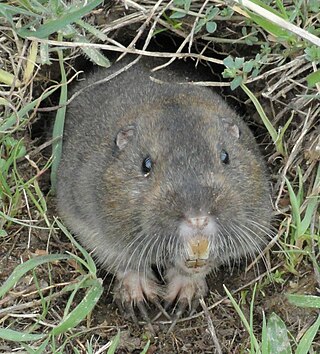
Genus is a taxonomic rank above species and below family as used in the biological classification of living and fossil organisms as well as viruses. In binomial nomenclature, the genus name forms the first part of the binomial species name for each species within the genus.

In taxonomy, binomial nomenclature, also called binary nomenclature, is a formal system of naming species of living things by giving each a name composed of two parts, both of which use Latin grammatical forms, although they can be based on words from other languages. Such a name is called a binomial name, a binomen, binominal name, or a scientific name; more informally it is also historically called a Latin name. In the International Code of Zoological Nomenclature (ICZN), the system is also called binominal nomenclature, with an "n" before the "al" in "binominal", which is not a typographic error, meaning "two-name naming system".

The lagomorphs are the members of the taxonomic order Lagomorpha, of which there are two living families: the Leporidae and the Ochotonidae (pikas). There are 110 recent species of lagomorph of which 109 are extant, including 10 genera of rabbits, 1 genus of hare and 1 genus of pika. The name of the order is derived from the Ancient Greek lagos + morphē.

Bovines comprise a diverse group of 10 genera of medium to large-sized ungulates, including cattle, bison, African buffalo, water buffalos, and the four-horned and spiral-horned antelopes. The evolutionary relationship between the members of the group is still debated, and their classification into loose tribes rather than formal subgroups reflects this uncertainty. General characteristics include cloven hooves and usually at least one of the sexes of a species having true horns. The largest extant bovine is the gaur.

Eutheria, also called Pan-Placentalia, is the clade consisting of placental mammals and all therian mammals that are more closely related to placentals than to marsupials.

Pocket gophers, commonly referred to simply as gophers, are burrowing rodents of the family Geomyidae. The roughly 41 species are all endemic to North and Central America. They are commonly known for their extensive tunneling activities and their ability to destroy farms and gardens.

Pytilia is a genus of small brightly coloured seed-eating birds in the family Estrildidae. They are distributed across Africa.

Achatina is a genus of medium-sized to very large, air-breathing, tropical land snails, terrestrial pulmonate gastropod mollusks in the family Achatinidae.
Amphorella iridescens is a species of air-breathing land snail, a terrestrial pulmonate gastropod mollusk in the family Ferussaciidae.
Amphorella melampoides is a species of air-breathing land snail, a terrestrial pulmonate gastropod mollusk in the family Ferussaciidae.
Amphorella hypselia is a species of air-breathing land snail, a terrestrial gastropod mollusc in the family Ferussaciidae.

Ferussaciidae is a family of air-breathing land snails, terrestrial pulmonate gastropod mollusks in the superfamily Achatinoidea.

Cal Islet is a small island about 500 m (1,600 ft) south of Porto Santo Island, in the Madeira Archipelago, Portugal. With an area of 1.40 km2 (0.54 sq mi), Cal is the largest of six islets close to Porto Santo. The highest point is 178 m (584 ft). The islet has never been inhabited.
Coleophora amphorella is a moth of the family Coleophoridae that is endemic to Iran.
Amphorella cimensis is a species of air-breathing land snail, a terrestrial pulmonate gastropod mollusk in the family Ferussaciidae.
Cimensis is a Latin adjective meaning "from Cima", referring to either Ilhéu de Cima of Cape Verde or Ilhéu de Cima of Madeira. It may refer to several species:
Gibbosporina is a genus of 13 species of foliose lichens in the family Pannariaceae. It contains species that molecular phylogenetic analysis clustered together in a clade previously referred to as the "Physma"-group. Despite their morphological differences, this group shares several uniting characteristics. They have ring-like excipular margins around the thallus; strongly amyloid internal ascus structures; well-developed perispores that feature irregular gibbae, but not verrucae ; lacks secondary compounds than can be detected by thin-layer chromatography; and have tropical distributions.
Gibbosporina amphorella is a species of foliose lichen in the family Pannariaceae. It was described as a new species in 2016 by Arve Elvebakk and Soon Gyu Hong. The specific epithet, derived from the Latin amphora ("urn") and ella-, refers to the small pycnidia, that are shaped like urns. The lichen is only known to occur in a small subtropical forested area in New Caledonia.










